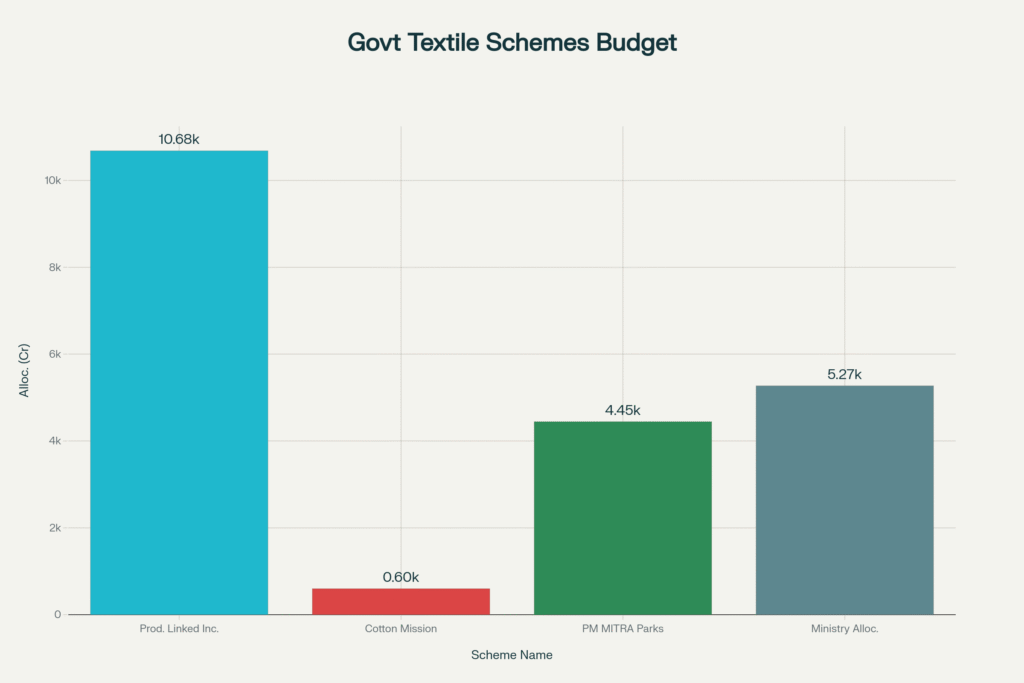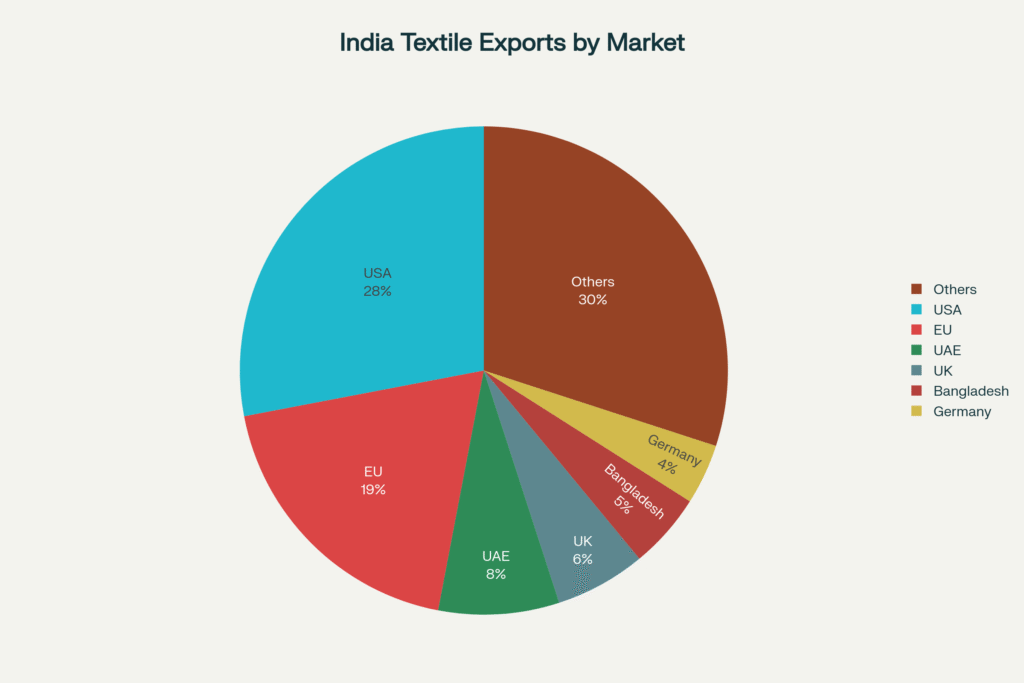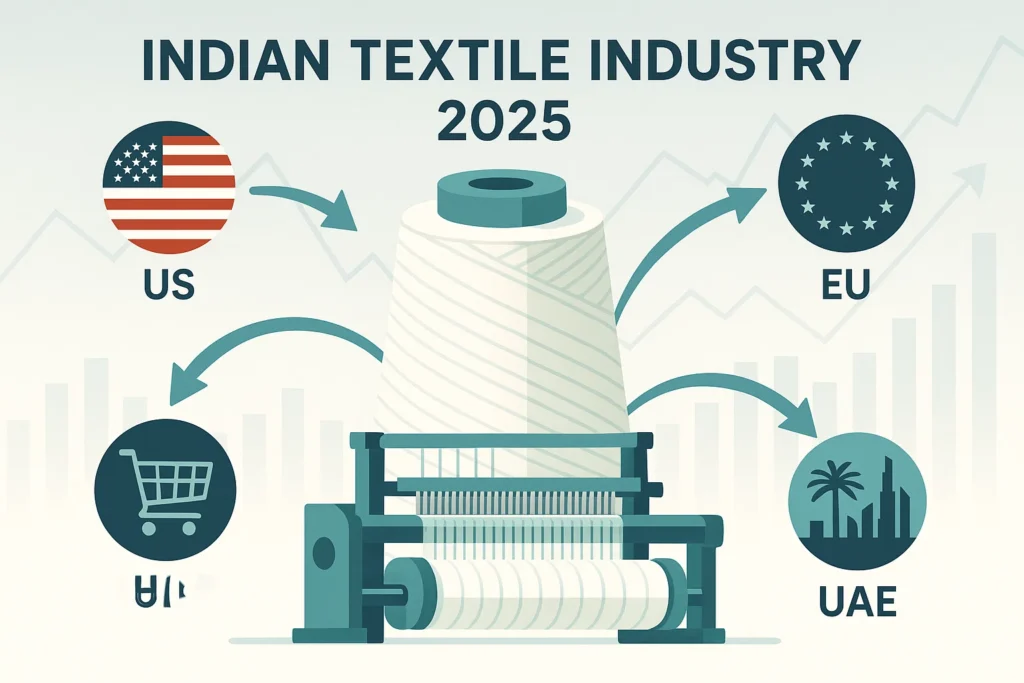Introduction: Textile to Stock Market
The Indian Textile Industry has always been a symbol of India’s economic and cultural identity. From handwoven khadi during the freedom struggle to today’s billion-dollar export markets, textiles are not just fabric — they are a story of resilience, livelihoods, and global ambition.
In 2025, this sector has entered a defining era. The government has made record-breaking policy announcements, global trade winds have shifted sharply, and stock market reactions have been nothing short of dramatic. For investors, traders, and policymakers, textiles in 2025 have become a sector to watch closely.
This detailed analysis covers the key government announcements, the stock market impact, the trade data, and the outlook for the future — with insights into where the opportunities and risks truly lie.
Government Announcements Driving the Sector
2025 has been a landmark year for textile-related policy. The government has rolled out schemes, lifted duties, and pushed investments to strengthen India’s competitive edge. At the same time, external trade shocks, especially from the United States, have tested the industry’s resilience.

Here’s a snapshot of the most important events so far:
| Month / Year | Announcement | Budget Allocation | Stock Market Impact |
|---|---|---|---|
| Feb 2025 | Union Budget 2025-26: Higher PLI allocation & Cotton Mission launch | ₹5,272 crore (minimum) | Positive – sector stocks rallied on funding news |
| Mar 2025 | PM MITRA Parks finalization (7 mega parks approved) | ₹4,445 crore | Positive – long-term growth expectations rose |
| Jul 2025 | US imposes 35% tariff on Bangladesh textiles | N/A | Indian textile stocks surged up to 15.5% |
| Jul–Aug 2025 | US hikes tariff on Indian textiles from 25% → 50% | N/A | Stocks fell 3–9% in 2 weeks |
| Aug 2025 | Cotton import duty scrapped till Sept 30 | N/A | Positive for manufacturers reliant on imported cotton |
The government’s message is clear: while domestic support remains strong, the industry must prepare for volatile international trade policies.
Stock Market Response: Winners and Losers
If 2025 has shown us one thing, it’s that textile stocks move sharply with tariff news. The year started strong with government funding optimism and Bangladesh’s tariff setback, but quickly turned into a tug-of-war once US tariffs on India doubled.
Here’s a closer look at how listed textile majors performed during these events:
| Company | US Revenue % | Impact (July 2025: Bangladesh Tariff) | Impact (Aug 2025: US 50% Tariff) | Analysis |
|---|---|---|---|---|
| Gokaldas Exports | 20% | +8.2% | -3.1% | Short-term gainer, but reliant on US orders |
| KPR Mill | 21% | +4.3% | -4.3% | Diversified portfolio cushioned impact |
| Vardhman Textiles | N/A | +4.3% | N/A | Domestic strength, less affected by tariffs |
| Arvind Ltd | 30% | -1.8% | -1.8% | Consistent pressure due to US dependence |
| Welspun Living | 30% | -1.9% | -1.9% | Similar to Arvind, hurt by tariff hikes |
| Pearl Global | 20% | +7.2% | -7.2% | Benefited from Bangladesh tariffs but crashed on Indian duty hike |
| Indo Count | 30% | -2.5% | -2.0% | Home textile demand hit by tariff costs |
| Kitex Garments | 70% | -5% | -5% | Most exposed; no diversification beyond US |
| Trident | 30% | -2.5% | -1% | Stable but sluggish |
Key Takeaway:
- Companies like Gokaldas Exports and Pearl Global thrived when Bangladesh faltered but quickly lost steam when the US turned its guns on India.
- Highly US-exposed firms like Kitex Garments are the most vulnerable.
- Diversified players like KPR Mill and Vardhman Textiles have shown relative resilience.
This highlights a critical point: diversification of export markets is not a luxury anymore; it’s survival.
Trade Performance: India’s Export-Import Balance
Despite trade headwinds, India’s textile exports have shown remarkable resilience. The industry has managed to bounce back after a weak FY 2023-24. Let’s look at the numbers.
| Period | Total Exports ($bn) | Textile Exports ($bn) | Apparel Exports ($bn) | Total Imports ($bn) | Export Growth Rate |
|---|---|---|---|---|---|
| FY 2023-24 | 35.87 | 20.62 | 15.99 | 8.95 | -2% |
| Apr–Jun 2024-25 | 9.08 | 4.94 | 4.14 | N/A | +3.37% |
| May 2025 | 3.20 | 1.69 | 1.51 | N/A | +3.47% |
| Apr–May 2025 | 6.18 | 3.30 | 2.88 | N/A | +5.36% |
Analysis:
- After a contraction in FY 2023-24, exports turned positive in 2024-25.
- Apparel exports are growing faster than textile exports, indicating India’s move toward value-added goods rather than raw material exports.
- Imports, especially of raw cotton, have increased after duty removal in Aug 2025, helping manufacturers lower costs but also raising dependency on global suppliers.
Market Distribution and US Dependency
One of the most defining characteristics of the Indian Textile Industry in 2025 is its deep connection with the United States. The US remains India’s single-largest textile export destination, accounting for nearly 28% of total exports. Between January and May 2025, India shipped textiles and apparel worth $4.59 billion to the US — a robust 13% jump over 2024 levels.
India’s Textile Trade Performance Trends
| Metric | Value | Observation |
|---|---|---|
| 2023-24 Total Exports (T&A) | $35.87 billion | Declined by 2% year-on-year |
| Global Market Share | 3.91% | India among top 5 textile exporters globally |
| Employment Impact | 45+ million people | One of India’s largest employers |
| GDP Contribution | 8.21% of total exports | Critical to India’s trade balance |
While exports are climbing back, imports have shown mixed trends. In FY 2023-24, India’s textile imports fell by 15% to $8.95 billion. However, in 2025, imports of raw materials surged:
- Raw cotton imports jumped 72.96% to $262.92 million (Apr–Jun 2025), highlighting dependence on external suppliers.
- Man-made textile imports grew 11.28% to $619.95 million, reflecting rising domestic demand for synthetics.
Regional Trade Performance
India is gradually diversifying its export basket, though the US remains dominant:
| Market | Share of Exports |
|---|---|
| USA | 28% |
| European Union | 19% |
| UAE | 8% |
| UK | 6% (with FTA benefits expected soon) |
| Bangladesh | 5% (for yarn & fabric re-exports) |
Recent Policy Interventions
To stabilize the sector, the government rolled out multiple supportive measures in 2025:
- Cotton Import Duty Removal: The 11% duty on raw cotton imports has been scrapped until September 30, 2025.
- Customs Duty Exemptions: Shuttle-less looms now enjoy full duty exemption to encourage modernization.
- Enhanced BCD on Knitted Fabrics: Raised to 20% or ₹115 per kg to shield local manufacturers.
Outlook: Growth vs. Challenges
The Ministry of Textiles has set bold targets: $100 billion exports and $250 billion domestic market size by 2030-31. Achieving this will require a 14% CAGR in exports and 9% CAGR domestically — ambitious but possible with sustained reforms.
However, the US tariff hikes remain a pressing concern:
- Current tariff on Indian textiles has surged to 50%, compared with just 20% on Bangladesh, creating a competitive imbalance.
- Companies with high US exposure face immediate margin pressure and reduced order flows.
- The industry is actively pursuing trade negotiations and market diversification to mitigate risks.
In short, India stands at a critical juncture: supported by progressive domestic policy but squeezed by global trade tensions in its largest export market.
Budget Allocations: Policy as a Growth Engine
India’s textile growth story in 2025 cannot be separated from its government schemes. From PLI incentives to cotton self-sufficiency, the allocations are paving the way for modernization.
| Scheme | Budget Allocation (2025) | Objective | Expected Impact |
|---|---|---|---|
| PLI Scheme | ₹10,683 crore (till 2030) | Boost manufacturing, attract ₹19,000 crore private investment | 7.5 lakh jobs, global competitiveness |
| Cotton Mission | ₹600 crore | Achieve self-sufficiency in ELS cotton | Reduce imports, strengthen supply chain |
| PM MITRA Parks | ₹4,445 crore (2025) | Create integrated textile hubs | Unlock ₹70,000 crore investment, create 20 lakh jobs |
Narrative Insight:
These schemes are more than numbers — they are India’s attempt to replicate its IT success story in textiles, moving from low-margin manufacturing to high-value exports backed by scale, integration, and quality.
India’s Global Textile Map
India’s textile exports are spread across multiple geographies, but the US remains the dominant buyer. This dependence is both an advantage and a risk.

India’s future strategy must be to reduce over-reliance on the US by expanding deeper into the EU, Middle East, and new growth markets like Africa and Latin America.
Outlook: Challenges and Opportunities Ahead
As 2025 unfolds, the Indian Textile Industry finds itself at a crossroads. The sector is being tested by global trade wars but is also supported by historic government initiatives.
Opportunities:
- India is positioning itself as an alternative to Bangladesh and China in global textile sourcing.
- Strong domestic support via PLI, Cotton Mission, and MITRA Parks is laying the foundation for sustained growth.
- Apparel exports are moving up the value chain, targeting global fashion and home textile markets.
Challenges:
- The US tariff escalation could hit short-term profitability.
- Heavy dependence on imported cotton makes India vulnerable to global price shocks.
- Competition from Vietnam, Turkey, and Pakistan remains a challenge in specific export categories.
Long-Term Vision:
India aims for $100 billion in textile exports by 2030-31, nearly tripling current levels. Achieving this requires a blend of policy execution, market diversification, and value chain modernization.
Final Thoughts on Indian Textile Industry
The Indian Textile Industry in 2025 is no longer just about traditional handlooms or commodity exports. It is about mega parks, policy incentives, global trade battles, and investor opportunities.
- Government support is stronger than ever, creating a solid domestic backbone.
- Global trade realities are volatile, requiring agility and diversification.
- Investors must carefully track policy signals and trade moves, as textile stocks are directly impacted by these shifts.
In short, 2025 has been a year of disruption, resilience, and opportunity. The story of Indian textiles is far from over — in fact, it may just be entering its most exciting phase yet.
FAQs on Indian Textile Industry 2025
Q1. What is the current size of the Indian Textile Industry in 2025?
The Indian Textile Industry is valued at over $150 billion, with strong growth in apparel and home textiles.
Q2. How important is the textile industry to India’s economy?
It contributes about 2% to India’s GDP, employs over 4.5 crore people, and is the second-largest export sector.
Q3. What government schemes support the textile sector in 2025?
Key schemes include the PLI Scheme, Cotton Mission, and PM MITRA Parks for integrated textile hubs.
Q4. How have US tariffs impacted Indian textile exports?
The recent hike in US tariffs from 25% to 50% has pressured exporters, especially those heavily dependent on the US market.
Q5. Which Indian textile companies gained from Bangladesh’s tariff setback?
Companies like Gokaldas Exports and Pearl Global saw gains when the US imposed tariffs on Bangladesh’s textiles.
Q6. Which companies are most vulnerable to US tariffs?
Firms like Kitex Garments, with over 70% US revenue, are highly exposed and vulnerable.
Q7. What is the export target for India’s textile industry by 2030?
India aims to achieve $100 billion in textile exports by 2030-31.
Q8. Which countries are the top markets for Indian textiles?
The USA (28%), EU, UK, and UAE are leading markets for Indian textile exports.
Q9. Why was cotton import duty removed in August 2025?
To give relief to manufacturers facing high raw material costs and ensure smooth supply for the industry.
Q10. What is the long-term outlook for the Indian Textile Industry?
Despite global trade challenges, strong policy support and diversification efforts position India for robust growth.
Related Articles
How a Tea Seller Used the Power of Compound Interest to Build ₹45 Lakh
China’s Fertilizer Export Halt to India: Stocks Set to Gain from the Supply Shock
The 15-15-15 Rule: Why the ₹1 Crore SIP Dream Needs a Reality Check






